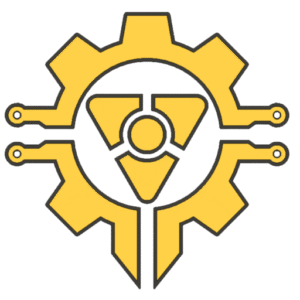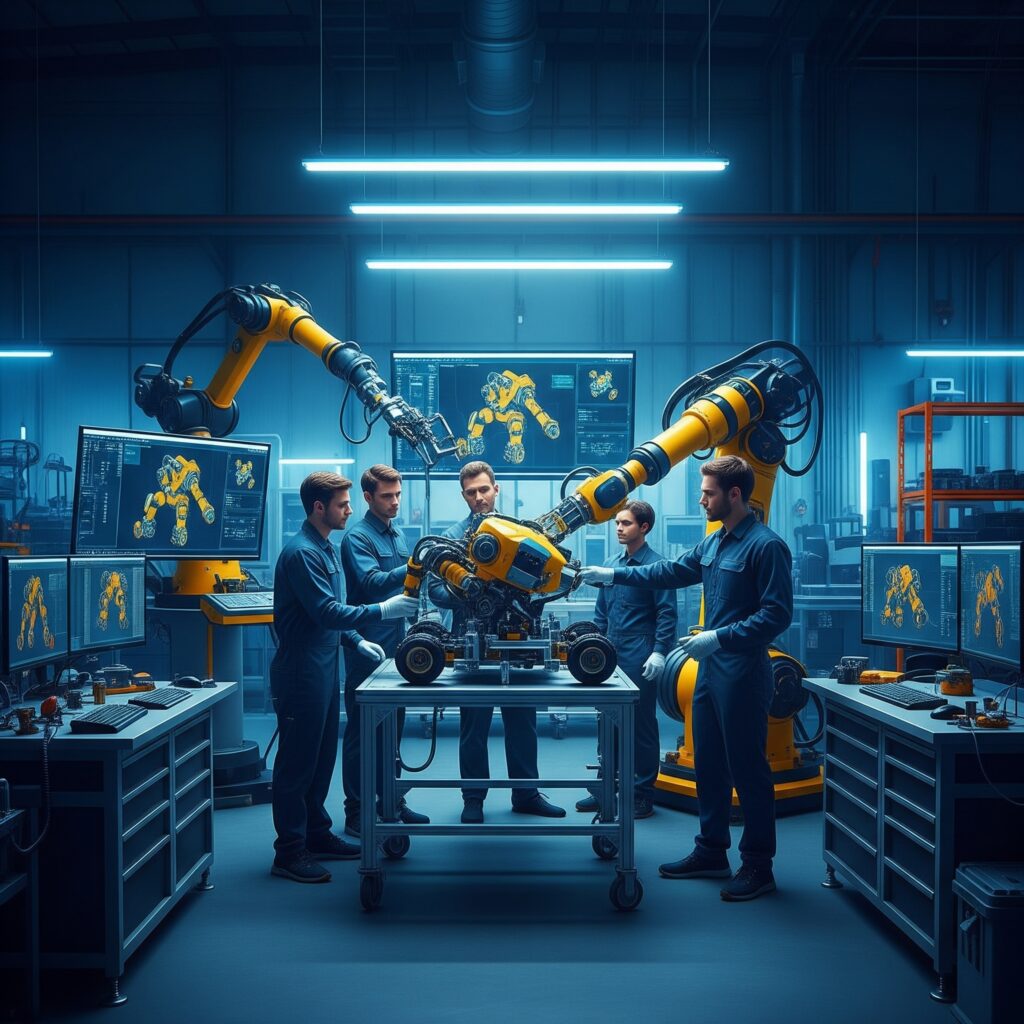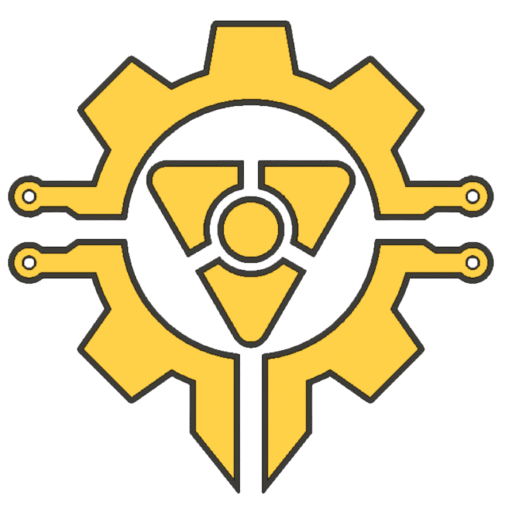Transforming Vision into Automated Reality: The Robotics Journey with WARNING MACHINES
Building a robot transcends merely conceiving a “cool idea.” It’s about meticulously translating that innovative concept into a tangible, functional product, one that’s mechanically robust, seamlessly integrated electronically, and ultimately ready for real-world deployment or scalable production. This complex journey, spanning multiple engineering disciplines, requires a blend of creative problem-solving and rigorous technical execution.
At WARNING MACHINES, we don’t just facilitate; we specialize in turning abstract concepts into complete, physical robotic and mechanical systems. Our expertise covers the entire robot development process, ensuring your vision evolves from initial sketches to a fully operational, production-ready machine. In this article, we’ll walk you through our proven, real-world methodology, from the nascent idea to the final delivery of your sophisticated robotic solution.
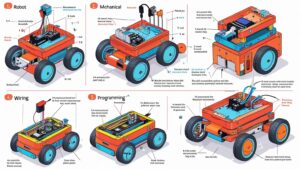
Define the Goal of Robot Development: The Blueprint for Robotic Success
Every successful robotic endeavor, regardless of complexity, begins with a crystal-clear mission. This foundational step is critical for aligning expectations and establishing a precise roadmap for development.
We initiate the process with a deep dive into your requirements, collaboratively answering key questions:
- What specific tasks or functions should this robot perform? Understanding its core utility is paramount.
- What environments will it primarily operate in? This dictates material selection, sealing, and sensor requirements (e.g., indoor, outdoor, hazardous, temperature extremes).
- What are the critical physical constraints? This includes size, weight limits, payload capacity, power source availability, and desired runtime.
- How intelligent or autonomous does it need to be? This defines the level of computational power, sensor fusion, and AI capabilities required.
The culmination of this phase is a comprehensive technical brief. This detailed document is a shared understanding between WARNING MACHINES and the client, meticulously shaping every subsequent design and engineering decision. This ensures alignment and minimizes costly revisions down the line.
Concept Design & Reverse Thinking: Crafting the Robotic Architecture for Robot Development
With the mission precisely defined, our expert mechanical and design engineers begin sketching out the robot’s core architecture. This phase blends innovative design with practical engineering principles.
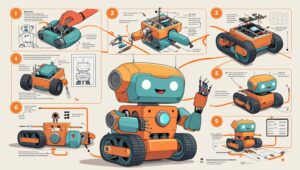
Key activities in Robot Development include:
- 3D CAD Modeling (SolidWorks, Fusion 360, or custom tools): Create detailed digital models defining the robot’s physical structure, component placement, and assembly interfaces. This is where the mechanical design truly takes shape.
- Designing Basic Movement Systems: Developing the kinematics for wheels, tracks, robotic arms, grippers, and specialized joints, ensuring optimal range of motion, load bearing, and stability.
- Modular Component Design: Incorporating modularity where possible to allow for future upgrades, easier maintenance, and scalability for different applications or variations of the robot.
- Aesthetics, Branding, and User Interface Elements: Integrating design considerations for the robot’s appearance, brand identity, and intuitive human-robot interaction.
We also strategically employ “reverse thinking” or reverse engineering when beneficial. We can identify proven concepts, potential pitfalls, and cost-saving opportunities by analyzing existing solutions or similar products, reducing overall project risk and development time.
Bringing the Robot Development to Life, Iteration by Iteration
This is where the abstract idea begins to take on a tangible form. The prototyping phase is rapidly creating physical versions to test and validate critical design assumptions.
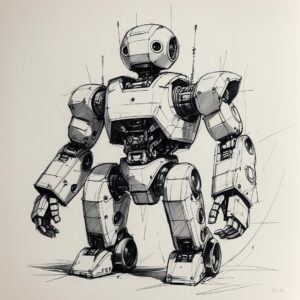
Our robotics prototyping services utilize:
- Rapid Prototyping Methods in Robot Development :
- 3D Printing: This is used to fabricate complex components, housings, and functional parts quickly to test form, fit, and basic mechanical function.
- CNC Machining: For higher-fidelity prototypes, functional parts made from production-grade materials (like aluminum), and components requiring tighter tolerances for rigorous mechanical testing.
- Mock Electronics & Wiring Looms: Creating preliminary electronic setups and wiring harnesses to test physical routing, interference, and basic circuit functionality.
- Rigorous Testing: We test prototypes for:
- Mechanical Tolerance: Ensuring parts fit together precisely and move as intended.
- Ergonomics: For human-robot interaction points, validating ease of use and safety.
- Component Fit and Integration: Confirming all internal and external components fit within the designed form factor.
This stage is designed to be fast, iterative, and incredibly insightful. It allows us to “fail fast” and learn crucial lessons efficiently, preventing costly redesigns later in the product development lifecycle.
Electronics & Integration: Making the Robot Development Smart
Once the mechanical framework begins to solidify, our electronics team takes the reins, infusing the robot with intelligence and control. This is where WARNING MACHINES’ interdisciplinary expertise truly shines.
This phase of Robot Development involves:
- Microcontroller Selection: The optimal brain for the robot (e.g., ESP32, STM32, industrial-grade microcontrollers) should be chosen based on processing power, I/O requirements, and cost.
- Sensor Arrays: Integrating various sensors (e.g., lidar, cameras, IMUs, force sensors) enables the robot to perceive its environment and operate autonomously.
- Motor Controllers & Actuators: Selecting and integrating the appropriate motor drivers and actuators (servos, stepper motors, DC motors) to achieve precise and powerful motion.
- Custom PCB Development: Designing and fabricating custom Printed Circuit Boards (PCBs) for efficient power distribution, signal integrity, and compact integration of all electronic components. Our PCB development services ensure reliability and manufacturability.
- Robust Power Systems and Wiring: Designing battery management systems, power regulation circuits, and durable wiring harnesses for safe and reliable power delivery.
- Embedded Software & Initial Firmware: Developing the low-level code that controls the microcontroller, interfaces with sensors, and manages motor movements, bringing the robot’s hardware to life.
Every circuit board is meticulously built, components are soldered, systems are tested, and firmware is refined in-house, ensuring seamless electronics integration.
Testing & Validation Proving Robot Development and Performance
With all systems integrated, the robot undergoes rigorous testing to simulate and exceed real-world operational conditions. This phase is critical for identifying and eliminating any weak links before deployment.
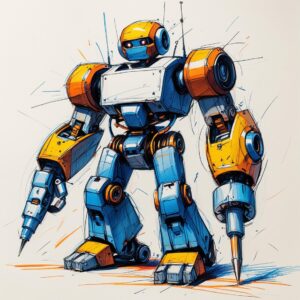
Our comprehensive testing protocols include:
- Load Testing involves evaluating the Robot Development and performance under maximum payload and stress conditions to ensure mechanical integrity and motor efficiency.
- Field Trials: Testing the robot in its intended operating environment to identify environmental interferences, navigation challenges, and overall performance in real-world scenarios.
- Battery Runtime Evaluations: Verify battery life under various workloads and optimize power consumption.
- Thermal Analysis and Stress Points: Monitoring component temperatures under sustained operation and identifying areas prone to overheating or mechanical stress.
- Electromagnetic Compatibility (EMC) Testing: Ensuring electronic systems do not interfere with each other or external devices.
- Software Debugging and Optimization: Fine-tuning algorithms and control loops for optimal performance and responsiveness.
Every identified weakness or performance bottleneck is exposed, analyzed, and systematically improved, ensuring the final robot meets all specifications for reliability and durability.
Final Build & Production Scaling for Robot Development
Once the design is fully validated and optimized through extensive testing, it’s time to transition to the final build and, if required, prepare for scalable production.
This crucial phase of Robot Development involves:
- Fabrication of Final Parts: Components are manufactured using production-grade materials, such as high-strength aluminum, lightweight carbon fiber, or high-grade polymers, to ensure durability and consistent quality. This often involves precision CNC machining and advanced fabrication techniques.
- Assembly Optimization involves streamlining the assembly process to improve repeatability, efficiency, and reduced manufacturing costs, particularly in low-volume manufacturing.
- Rigorous Quality Control (QC): Implementing strict inspection and calibration procedures to ensure every unit meets the highest standards of performance and craftsmanship.
- Final Calibration for Robot Development: Calibrating sensors, motors, and control systems to achieve optimal accuracy and performance.
Depending on the project’s scale and the client’s needs, WARNING MACHINES will either hand over the fully assembled physical unit ready for deployment or provide comprehensive documentation and support for a seamless manufacturing handoff to a larger production facility.
Robot Development, Realized by WARNING MACHINES
WARNING MACHINES offers comprehensive, end-to-end product realization, especially for complex robotic and mechanical systems- from initial sketches and intricate circuit designs to a fully functional, intelligent machine. Our multidisciplinary team, in-house capabilities (including CNC machining, 3D printing, PCB development, and assembly), and proven process ensure that your innovative ideas are translated into robust, market-ready products.
Whether you’re an ambitious startup with a groundbreaking robotics concept or an established manufacturer seeking to innovate and integrate new automated solutions, we’ve built the systems, assembled the expert teams, and refined the processes to help you launch with confidence. We understand the nuances of robotics engineering and are committed to bringing your vision to life as a tangible, successful reality.
Ready to build the future of robotics? Contact WARNING MACHINES today to discuss your next breakthrough project.
You can read more prototyping articles in the Warning Machines blog :
